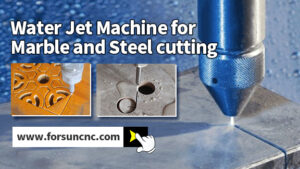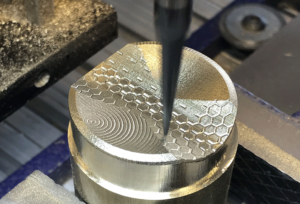Laser cutters are great tools that offer the possibility to create many different things. The laser cutting process provides accurate and excellent cut quality on aluminum and stainless steel sheets. It ensures a small kerf width and minimal heat-affected zone; therefore, it is best suited for cutting complex holes and shapes.
In this beginner’s guide, I’ll explain how a laser cutter works, show you some examples of things you can make with a laser, and how to create designs for laser cutting or engraving. You will also learn what materials are available and how to use a laser cutter.
What is a laser cutting machine?
A laser cutting machine is a kind of CNC machine tool. CNC stands for Computer Numerical Control. A laser cutter is a manufacturing tool that uses a laser beam to cut material to create patterns or designs. With a laser cutter, you can manufacture parts or engrave designs on materials such as metal, glass, wood, and plastic.
Laser cutting can be compared to conventional saws. The difference between the two is that the laser cutting machine offers better precision, and higher precision, and is completely controlled by a programmed computer, making the entire process non-contact.
How does a laser cutting machine work?
Laser cutting is a thermal cutting process. The laser beam is generated in the laser unit and passes through the nozzle in the direction of the workpiece. The liquefied material blown out by the cutting gas is additionally caused by the movement of the nozzle or the nozzle of the workpiece forms the desired cutting growth.
Here’s an easier way to understand it. The laser cutting process is a precise and highly precise laser beam that passes through the material you are cutting. The laser melts the material as it runs over it.
You can choose to use a pulsed beam or a continuous beam. Beam intensity, length, and heat output can be controlled, but this depends on the material you choose to use. Laser cutting is very accurate and provides a clean and smooth surface. The beam enables cuts as small as 0.1 mm.
In the process of cutting stainless steel and aluminum, the beam melts the material, and nitrogen is used to blow the liquefied metal out of the cut.
Types of laser cutting machines:
Laser cutting processes are roughly divided into three categories. One is carbon dioxide, the second is crystal laser cutting, and the last is fiber laser cutting.
C02 Laser Cutting Machine
Cutting is done using the electrical stimulation of carbon dioxide. CO2 lasers are produced in a mixture of other gases such as nitrogen and helium. The CO2 laser emits a wavelength of 10.6 mm, and the CO2 laser has enough energy to penetrate thicker materials than a fiber laser with the same power. These lasers also provide a smoother finish when used to cut thicker materials. CO2 lasers are the most common type of laser cutter because they are efficient, inexpensive, and can cut and raster a wide variety of materials.
Materials: Glass, some plastics, some foams, leather, paper products, wood, acrylic
Crystal laser cutting machine
Crystal laser cutting is an amalgam of neodymium-doped yttrium orthovanadate and neodymium-doped yttrium aluminum garnet lasers. A crystal belonging to the solid-state laser group with wavelengths similar to fiber lasers. Therefore, they are suitable for cutting metals and non-metals.
Materials: Plastics, metals, and some types of ceramics
Fiber Laser Cutting Machine
Fiber lasers are generally maintenance-free and have a long lifetime of at least 25,000 laser hours. As a result, fiber lasers have a much longer lifespan than the other two types of lasers and can produce powerful and stable beams. At the same average power, they can manage 100 times higher intensities than CO2 lasers. Fiber lasers can be continuous beams, collimated, or provide pulsed setups that give them different capabilities.
Fiber lasers are best suited for metal marking by annealing, metal engraving, and thermoplastic marking. It works with metals, alloys, non-metals, and even glass, wood, and plastic. Depending on the power, fiber lasers are very versatile and can handle a large number of different materials. Fiber lasers are the ideal solution when working with thin materials. However, this is not the case for materials over 20mm, however, more expensive fiber laser machines over 6kW can do the trick.
Material: Plastic and Metal
Among the three types of lasers, fiber laser cutters are most commonly used by manufacturers and professionals, and they are mainly used to cut metal materials.
What materials can a laser cutter cut?
- Copper, gold, nickel, silver, steel, titanium, tungsten, and other metals.
- Reflective metal
- Safe and precise cutting of silicon.
- Various ceramics
- Different glass types
- Woodcut
- Gem material
In which industries can you find laser cutting?
The laser cutting process is used in several industries, these industries are as follows:
-
Automobile industry
Several benefits of laser cutting in the automotive industry include cutting cabin components that fit together and cutting airbags. The laser cutting process can be used in the electric vehicle industry, such as battery foil cutting, stator plate cutting, etc.
-
Aerospace industry
Laser cutting is widely used to cut high-strength aluminum alloys to provide a good finish and minimal heat-affected zone, which was not possible before.
-
Electronics industry
Over the past two decades, electronic parts have become smaller and more complex than ever before, and only laser cutting can produce the desired results. In the electronics industry, laser machines are best for cutting circuit boards and dollar cards.
-
Medical department
In the medical field, laser cutting is used for precision cutting of high-grade sheet metal, pipe cutting, and various medical applications.
What can you do with a laser cutter?
Generally speaking, a laser cutter can perform three tasks: cutting, engraving, and marking.
In fact, the only difference between cutting, engraving, and marking is the depth of the laser and how it changes the overall appearance of the material. In laser cutting, the heat from the laser cuts the material all the time. But that’s not the case with laser marking and laser engraving.
Laser marking discolors the surface of the material being laser processed, while laser engraving and etching remove parts of the material. The main difference between engraving and etching is the depth of laser penetration.
Following are the differences between marking and engraving:
Laser Marking: In laser marking, the laser does not penetrate the material all the time, but only changes the properties or appearance of the material. Lasers produce high-contrast marks because the heat of the laser redistributes the carbon in the associated material.
Laser Engraving: In laser engraving, a beam of light physically removes the surface of the material, leaving a cavity that showcases your design. The laser heats the material to very high temperatures, causing it to evaporate and form a cavity.
Advantages and disadvantages of laser cutting machines
Advantage
Laser cutting is preferred over other cutting techniques such as CNC milling for the following reasons:
- High precision and accuracy
- Fast production
- More affordable than CNC machines of the same caliber
- Broad material compatibility
- No risk of contamination (as it is a non-contact process)
- Narrower incision width
Shortcoming
- High energy consumption
- Risk of Toxic Emissions Release (from Plastics)
- Thicker materials can be difficult to cut
- Risk of burning edges when cutting
How to operate a fiber laser cutting machine for beginners?
-
Prepare
Be sure to read and understand all safety instructions that come with your laser cutter before using it.
Fix the metal material to be cut firmly on the table.
According to the material and thickness of the metal sheet, adjust the laser power, cutting speed, focal length, and other equipment parameters.
-
Create the Laser Cut File
Perform the programming of the workpiece drawings and the layout of the whole board cutting. It is then transferred to the cutting software system for cutting. Note that the Metal Laser Cutter requires a vector path as an input file.
-
Start laser cutting
Try cutting the material. After overcutting, carefully check the verticality, roughness, burrs, and dross of the cut surface.
Analyze cut surfaces and inspect samples. Then adjust the parameters in time when problems arise. Multiple adjustments may be made until the cut meets process requirements.
Note for operators of fiber laser cutting machines
Fiber lasers are very dangerous due to their huge energy and fast cutting speed, so workers must pay great attention when using fiber laser cutting machines. Once the danger occurs, the consequences will be unimaginable. Attentions for fiber laser cutting machine staff, let’s take a look at the specific content!
- Strictly abide by the safety operation rules of the cutting machine, and operate according to the operation manual;
- The operator of the fiber laser cutting machine must be specially trained to a certain level, and can only operate with the consent of the safety administrator;
- Delineate the laser safety management area, and set up warning signs at the entrance and exit of the management area, including the power of the laser processing machine, the type of laser, prohibiting outsiders from entering, paying attention to eye protection, personnel names, and other safety managers;
- There shall be no inflammable and explosive materials in the working area, and corresponding preventive facilities shall be provided at the same time;
- When the equipment is working, the operator shall not leave the work post without authorization or be taken care of by others, and shall cut off the power supply or stop the machine;
- Operators of fiber laser cutting machines or those who approach the laser during laser use should wear appropriate laser safety glasses and protective clothing. In the area of protective glasses, there must be good indoor lighting to ensure the smooth operation of the operator;
- Until you know if a material can be irradiated or heated by a laser, don’t claim to be processing it for the potential danger of producing fumes and vapors.
Key considerations when buying a laser cutter
Support: Some suppliers offer cheap laser cutters, but are they reliable enough? Is it possible to provide you with the necessary support should your machine fail and how easy it is to find replacement parts?
Size: The size of the bed limits the size of the material you can use. Larger beds allow you to cut multiple pieces at once, while smaller beds can only handle one material at a time
Power: The more watts, the more powerful your machine. Remember, more power means you’ll cut faster and more reliably. Less powerful lasers will slow you down.
Compatible Materials: You can’t just pick any material and start blasting it with a laser. The composition of the material should guide you when choosing the right laser cutter. Also, be aware that some materials will catch fire, while others will produce toxic fumes.
Entry-level fiber laser cutter for beginners
FORSUN CNC is a high-efficiency fiber laser cutting machine manufacturer in China. Our range of high-precision laser cutters is best suited for a variety of applications. These include sheet manufacturing, outdoor advertising, vector cutting, sign making, raster engraving, textile manufacturing, and more. Our industrial CNC laser cutters are designed to eliminate costly mistakes, reduce material waste and increase your overall productivity.
Below FORSUN CNC will introduce four metal fiber laser cutting machines for beginners. The functions are complete, the cutting effect is good, and the operation is very convenient. At the same time, fiber laser cutting machines are affordable and cost-effective. If you want to try to buy a good CNC fiber cutting machine, you may refer to the following four metal fiber laser cutting machines.










